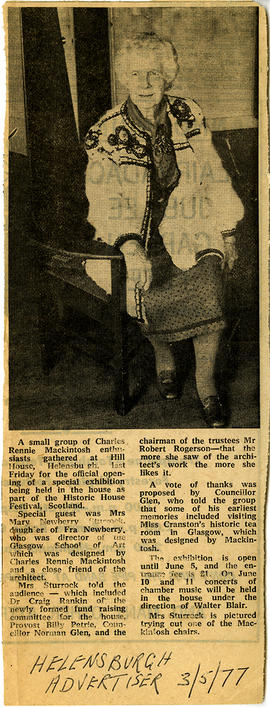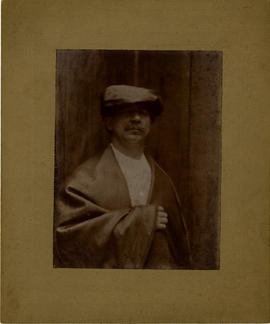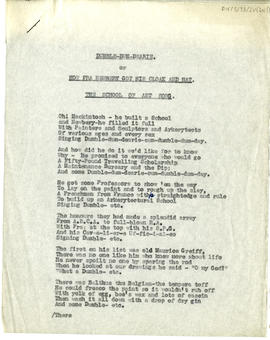Key Information
Reference code
Title
Date(s)
- c1889-1996 (Creation)
Level of description
Subseries
Extent
1 archive box
Content and Structure
Scope and content
Later accessions of material relating to Francis Newbery. Material was not deposited as part of his working papers as Director of the School, but includes some working papers and correspondence from during his time as Director in addition to papers dating to after his retirement, family records and photographs, and written materials regarding Newbery.
Includes:
- DIR/5/38/1: Correspondence, 1889-1947
- DIR/5/38/2: Working Papers of Francis Newbery, 1902-c1910
- DIR/5/38/3: The 'Masque of the City Arms' Papers and Correspondence, 1905
- DIR/5/38/4: The Teaching of Design, Papers and Correspondence, 1910
- DIR/5/38/5: Needlecraft in Secondary Schools Papers and Correspondence, 1910-1912
- DIR/5/38/6: Family Papers, 1906-1984
- DIR/5/38/7: Family Photographs, c1895-c1980s
- DIR/5/38/8: Materials relating to Francis Newbery
See this blog-post for more information about the discovery of these materials: http://www.gsaarchives.net/2018/03/cataloguing-gsa-famous-friends-fra-newbery-discovered/
Appraisal, destruction and scheduling
Accruals
System of arrangement
Arranged into themed folders as described and chronologically within.
General Information
Name of creator
Biographical history
Francis Henry Newbery, known as Fra. Newbery, was the Headmaster and Director of the Glasgow School of Art from 1885 to 1918. During that time the profile of the School was raised from that of a moderately successful institution to one an international reputation.
Newbery was born on 15 May 1855 in Membury, East Devon. He grew up in Dorset and studied as an Art Master in Bridport, before moving to London in 1875 to continue working as an Art Master there. In 1877 he started attending the National Art Training School at South Kensington where he was taught by Edward Poynter and other artists of the time. By 1885 he had taught in most of the School's classes and, at the age of 30, was appointed to the post of Headmaster of Glasgow School of Art.
His success at Glasgow School of Art was led by the acclaim and notoriety surrounding the work of designers and artists such as Charles Rennie Mackintosh, Margaret Macdonald, Frances Macdonald, Herbert McNair, Jessie M. King and others working in the 1890s in Glasgow. It was most highly acclaimed at the Turin Exhibition of Decorative Art, 1902. Much of this success was due to Newbery who selected the work and chose Mackintosh to design the rooms for its display. For this work Newbery was awarded an Italian knighthood.
Newbery oversaw the erection of the new School building at 167 Renfrew Street. He had drawn up the brief, based on his own personal experience and the demanding Department of Science and Art specifications, and he appreciated Mackintosh's design for its practical interpretation. In favouring Mackintosh's plans, he was supported by the Governors of Glasgow School of Art and the official Department of Science and Art advisors.
Under the Scottish Education Department in 1901, Newbery devised his own curriculum which led to the award of a Diploma. The course was divided into four stages, which did not necessarily correspond to years - students were moved through at their own pace, some taking seven or eight years and others only three. Many were not ever awarded the Diploma.
Staff brought in by Newbery to teach at the School included, among others, the Belgian Symbolist painter Jean Delville, the English portraitist, Maurice Greiffenhagen, the French Adolphe Giraldon, the English Decorative artists W.E.F. Britten and Robert Anning Bell and, as Head of Architecture, the French architect Eugene Bourdon. There was also a strong core of Glasgow School of Art trained teachers including Jessie Newbery, Anne Macbeth, Dorothy Carleton Smyth, Olive Carleton Smyth, Allan D. Mainds, James Gray and de Courcy Lewthwaite Dewar.
Newbery inaugurated many schemes at the School including the Glasgow School of Art Club and the Artist Teachers' Exhibition Society, both of which encouraged exhibitions and competition within the School, and allowed present and former staff and students to meet. He invited leading figures in the art and design worlds to lecture at the School including Walter Crane, C.F.A. Voysey, William Morris and Lewis F. Day. He established good contacts with Glasgow University so that the students received lectures in anatomy, art history, philosophy and literature, beyond those available within the School.
Newbery exhibited with the Glasgow Boys, and had close ties to John Lavery, James Guthrie and E.A. Walton. His paintings were exhibited world-wide and he was particularly successful in Italy. From 1890, most of his holidays were spent in Walberswick, Suffolk, often in the company of other Scottish artists, such as Mackintosh and the young W.O. Hutchison.
In 1918 he was granted early retirement on medical grounds, and moved to Corfe Castle, Dorset where he continued to paint, mainly in the field of public art. He died at the age of ninety-one on 18 December 1946. Jessie Newbery died sixteen months later.
Name of creator
Biographical history
Jessie Wylie Newbery (1864–1948) was born in Paisley, near Glasgow, on 28 May 1864, one of the four children of William Rowat and his wife, Margaret Downie Hill. William Rowat was a shawl manufacturer and later tea importer who had strong views on the education of women. Like her father, Jessie had an independent nature. At the age of eighteen she visited Italy, where she became interested in mosaics, textiles, pottery, and ‘peasant crafts’. Throughout her life she collected textiles from Italy, Russia, and the Balkans. In 1884 she enrolled as a student at the Glasgow School of Art, and ten years later she became head of the school's department of embroidery, which she had established earlier. She married Francis H Newbery four years after his appointment as headmaster, on 28 September 1889. Her work raised the status of embroidery to that of a creative art form.
"She evolved a characteristic linen appliqué … worked on linen ground, with applied simple stylized flowers and leaves, cut out of coloured linens and held down by satin stitch in silk … the stems coiled into strong lines, outlining the shape of the article". (Swain, ‘Mrs J. R. Newbery’, 105)
She ‘liked the opposition of straight lines to curved; of horizontal to vertical … I specially aim at beautifully shaped spaces and try to make them as important as the patterns’ (ibid.). The Glasgow rose, emblem of the Glasgow style, ‘is believed to have evolved from her circles of pink linen, cut out freehand and applied with lines of satin stitch to indicate folded petals’ (ibid.). She introduced lettering, mottoes, and verses as part of her designs, and also taught needleweaving and dress design. In an interview with Gleeson White she commented, ‘I believe in education consisting of seeing the best that has been done. Then, having this high standard thus set before us, in doing what we like to do: that for our fathers, this for us’ (G. White, 48). She was a fine teacher and inspired many of her students.
At the same time Mrs Newbery managed her mercurial husband and brought up two daughters, Elsie and Mary, for whom she designed artistic yet practical dresses, as she designed and made her own attractive clothes. Her original and individual designs for dresses incorporating embroidery set a style for her students which was emulated by many of the Glasgow Girls, including the Macdonald sisters, Margaret and Frances. Like women in other artistic circles, for example, Jane and May Morris, Jessie Newbery wore dresses of an Italian Renaissance appearance, though she also believed that dress should be practical as well as beautiful. At a school at-home in November 1900:
"her black merve [sic] gown was slightly trained and had the long sleeves puffed at intervals to correspond with the simply fashioned bodice which was finished with a narrow collar of old lace, and on the shoulders bows of reddish gold velvet". (Burkhauser, 148)
It was later noted that ‘she never wore a corset in her life … she deplored the tight lacing imposed by the current fashion’ (ibid., 50), a comment that reveals her interest in rational dress (she possessed a ‘rational’ skating costume with red flannel bloomers). In 1918 she retired with her husband to Eastgate, Corfe Castle, Dorset, where she died on 27 April 1948.
Jessie's two younger sisters, Margaret (Madge) Finlayson Rowat, 1864-1948, and Mary Margaret Hill Rowat 1873-1970, also studied at the GSA. Madge appears in the Registers from 1884 to 1902 and won several local prizes for her composition, best studies of heads painted from life and heads from life in watercolour in 1890. Mary enrolled in 1897, giving her occupation as designer.
Name of creator
Biographical history
Mary Newbery Sturrock (1892-1985), née Mary Arbuckle Newbery, was a Scottish artist who worked primarily in watercolour, embroidery and ceramics. The daughter of Francis Henry Newbery, Director of The Glasgow School of Art 1885-1918, and Jessie Newbery, designer, embroiderer and Glasgow Girl, she grew up in Glasgow with her elder sister Elsie (Margaret Elliot). Between 1911 and 1914, Mary studied in the Life School of Drawing and Painting at The Glasgow School of Art.
Her closest friend and artistic contemporary was Cecile Walton (1891-1956), daughter of the artists Helen and Edward Arthur Walton. The Newberys and Waltons were close family friends, renting houses near to each other in Suffolk as part of a wider artistic community that visited the area. This community also included William Oliver Hutchison and Eric Robertson, who became Cecile Walton’s first husband. A 1912 painting by Cecile depicts Eric and Mary posed languorously in a garden, Robertson reclining and Newbery sitting with a crown of flowers in her lap; a nod toward the symbolism that flowers hold in Newbery’s own work. The painting, ‘Eric Robertson, 1887 - 1941. Artist. With Mary Newbery, 1890 – 1985’, is held by the National Galleries of Scotland and displayed at the Scottish National Portrait Gallery.
Cecile Walton later introduced Mary to her own husband, the painter Alick Riddell Sturrock (1885-1953). The pair met in Suffolk and married on 21 October 1918 once Alick had returned from the First World War. Their wedding was held at Corfe Castle in Dorset, where Mary’s parents had moved upon Francis Newbery’s retirement. After the war, both Mary and Alick exhibited as part of the Edinburgh Group of artists, initially formed in 1912 and reconstituted in 1919, alongside artists including Cecile Walton, Eric Robertson, David Macbeth Sutherland and Dorothy Johnstone. The group held annual exhibitions at the New Gallery in Shandwick Place in 1919, 1920 and 1921. In the 1920 exhibition, a set of Mary’s embroidered cushions were reviewed favourably in The Scots Pictorial, which noted Newbery’s ‘fine sense of colour and design’.
In 1926, Mary and Alick moved to Gatehouse of Fleet, where they lived until 1934. In 1935, the couple moved to Edinburgh and lived at 2 Mansfield place until around 1945, when they moved to 13 South Gray Street where Mary would live the rest of her life. GSA holds a number of copies of a hand-drawn and printed change of address card for this move. Between 1935 and 1952, while living in Edinburgh, Mary submitted at least one watercolour per year to the Royal Scottish Academy exhibition. Examples include 'A July bouquet' (1940) and 'Dusty miller posy' (1946), which are demonstrative of Mary’s artistic style and practice and her unceasing interest in natural themes and subjects. Newbery also exhibited across her career at the Royal Glasgow Institute of the Fine Arts, where she showed some of her earliest works. Between 1911 and 1949, a number of pieces exhibited in the Royal Scottish Academy were also shown in Glasgow.
Mary’s best known and most recognisable works are watercolour paintings of flowers, which she made throughout her life. Her early work was especially influenced by Charles Rennie Mackintosh, whom, a close friend of the Newbery family, she had grown up around and often watched draw. Towards the end of his career, Mackintosh worked on his own botanical watercolours, and the two would often paint the same flowers. Mary would provide their Latin names so Mackintosh could inscribe them correctly. Whilst Newbery Sturrock and Mackintosh remained close friends throughout his life, her later work deviated somewhat from his influence and became more naturalistic.
Following the death of her husband in 1953, Mary travelled extensively. Later in life, she gave various interviews to art historians and biographers about her knowledge of The Glasgow School of Art, her father Francis Newbery and both her own and her father’s relationship to Mackintosh. For example, in 1973 she spoke with June Bedford and Ivor Davies for Connoisseur magazine about Mackintosh, and in the early 1980s, spoke with Anthony Jones (director of GSA 1980-6) about the history of The Glasgow School of Art, Fra Newbery and Mackintosh.
In 1983, a touring retrospective devoted to the Edinburgh Group was held at the City Art Centre Edinburgh in which both Mary and Alick were profiled. Mary exhibited examples of work across the applied and decorative arts, including floral watercolours, embroidery, ceramics and a sketchbook containing pen, ink and watercolour sketches of figures and flowers. Two years later, in 1985, Mary passed away aged 93.
Name of creator
Biographical history
Anthony Jones is an internationally known arts administrator, broadcaster, writer, and historian of art and design. He is Chancellor of the School of the Art Institute of Chicago. He was born in Great Britain, and educated there and in the U.S. Among several CEO positions he served as the Director of the Glasgow School of Art (1980-1986), and was appointed by Queen Elizabeth II as Director of the Royal College of Art, London (1992-1996). Professor Jones has published several books and many essays on art and design, curated numerous exhibitions, and has hosted several television series for the BBC in Great Britain. He is a recognized authority on the development of art, design and architecture of the nineteenth and twentieth centuries, in particular the work of architect and designer Charles Rennie Mackintosh, and Celtic Revival designer Archibald Knox. He is honorary Director of the Osaka University of the Arts, Honorary Professor of the University of Wales, was conferred the Austrian Cross for services to European education, and is a Fulbright Scholar. He has been awarded four Honorary Doctorates, was made an Honorary Member of the American Institute of Architects, is the Senior Fellow of the Royal College of Art, London, and a Fellow of the Royal Society of Arts, and received the Award of Distinction of the American National Council of Arts Administrators.
Name of creator
Biographical history
Isobel Johnstone is an artist and curator from Glasgow. She studied Fine Art at Edinburgh University and College of Art and between 1969 and 1973, worked as a Lecturer in art history and drawing tutor at Glasgow School of Art. In 1975, she published her PhD thesis on Walter Crane under her then married name Isobel Spencer. Between 1975 and 79, she worked in Edinburgh as Curator of the Arts Council Collection and subsequently moved to London as Head of the Arts Council Collection. She retired in 2004 in order to devote time to painting.
Archival history
Custodial history
GSAA/DIR/5/38 comprises later accessions of material relating to Francis Newbery. The majority of this material was found in a box alongside material relating to the exhibition: 'Fra H Newbery, Artist and Art Educationalist, 1855-1946', The Glasgow School of Art 29 Jul-30 Aug 1996, George Rawson. The exhibition papers are now housed within the curator's exhibition files. GSAA/DIR/5/38/6 and GSAA/DIR/5/38/8 include additional material that has been transferred from GSA Library.
Physical Description and Conditions of Use
Conditions governing access
Conditions governing reproduction
Language of material
Script of material
Language and script notes
Physical Description
Finding aids
Related Material
Existence and location of originals
Existence and location of copies
Related materials
Notes area
Alternative identifier(s)
Keywords/Tags
Place access points
People and Organisations
- Newbery, Francis Henry (Subject)
- Sturrock, Mary Newbery (Subject)
- Newbery, Jessie Wylie (Subject)
- Mackintosh, Charles Rennie (Subject)
- The Glasgow School of Art (Subject)
- Baltus, Georges-Marie (Subject)
- Greiffenhagen, Maurice (Subject)
- Dunlop, James Morton (Subject)
- Huck, James (Subject)
- Gray, James (Subject)
- Crane, Walter (Subject)
- Bell, Robert Anning (Subject)




